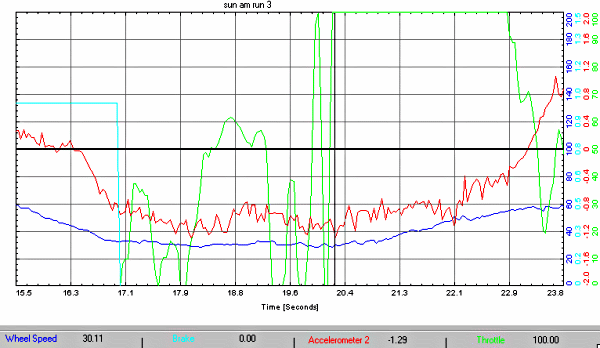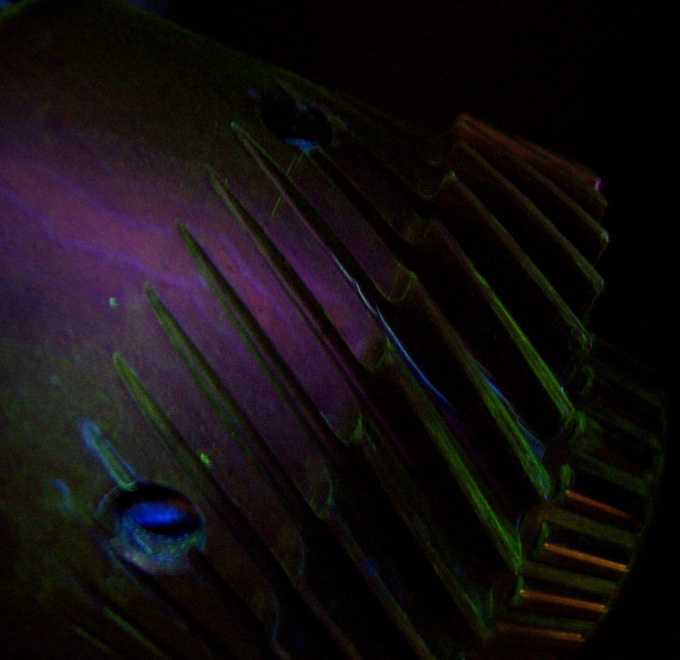Quaife Centre and Front Diffs
Thanks to the hard work of the transmission wizards at TRE we managed to start the 2002 ProSolo season off with a pair of Quaife Torsen limited-slip differentials in the centre and front positions inside the transmission.
This was primarily done to replace the known to be fragile factory units, but it seems that it had another effect, that while it was not altogether unforeseen, neither was it a given just from the theory.
A stock Talon/Eclipse uses a viscous-style diff in the centre slot and a conventional "open" differential in the front slot. The viscous coupling, while very effective at transferring power from one set of axles to the other, is a little slow to react, dependant as it is on the fluid inside the coupling unit heating up in order to provide maximum locking force. This means that there is a time delay between an axle starting to slip, and the viscous sending power to the other end of the car to compensate.
With the open front diff, there is no locking mechanism at all to transfer power from one front wheel to the other should one wheel start spinning. Furthermore, like all open diffs, once a wheel starts spinning, all the power is sent to the spinning wheel, not the wheel that still has grip.
So in a corner-exit situation, where power is being applied, if one of the front wheels were to break loose, all the power sent to the front axle would be diverted to the spinning wheel. And as there is a time delay at the centre viscous coupling before it starts locking and sending power to the rear wheels, that wheelspin is going to last for a little bit.
The result is power-on understeer that effectively limits how early and aggressively you can get back on the throttle, especially in a powerful Talon/Eclipse. Paradoxically, a less powerful car can use more throttle leaving the corner, as it never makes enough power to threaten overpowering one of the front wheels and inducing understeer.
Inside the car, it feels like this: you apply throttle, the engine revs up, the car starts understeering but the car doesn't really start accelerating. Then the revs will drop somewhat and the car will lurch forward. It feels something like a slipping clutch that suddenly engages (probably because it is, if you treat the viscous coupling as a kind of clutch).
This is doubly painful in an AWD car, because the ability to jump back on the throttle early is the chief advantage of AWD over RWD or FWD. If you are not making use of that advantage, then you are hauling all the extra weight of the AWD drivetrain for no benefit.
Installing the Quaife diffs solved that problem; thanks to datalogging, it can be demonstrated.

This is a log of the turnaround at the 2002 Ft Myers ProSolo. The dark blue line is wheel speed. The red line is lateral G. The green line is throttle position, and the light blue line is brakes on/off. The horizontal black line is 0G lateral, and the vertical black line is the cursor, at which you can read the values of the various traces below the graph.
What the Lateral G trace shows is a turn with a sharp entry followed by a slightly flatter centre section that then tightens up a little bit before opening up and then feeding (at the extreme right) into another turn in the opposite direction.
The interesting trace here is the throttle. Note no throttle under the brakes at corner entry. Mid-corner, there is some modulation, followed by a lift to get through the second, tighter apex. There is a quick stab to full throttle to see what the car will do, and when there is no push, the throttle is planted at 100% and held up to the entry of the follow-on turn.
Now, take a closer look at the lateral G trace in this full-throttle section. Notice that the car goes full throttle at the lateral G peak. Notice as well that lateral G falls off (which is consistent with unwinding the steering wheel) but then there is a little peak (at time 22.1) - this is a steering correction made at full throttle! In other words, the turn needed to be tightened somewhat, the wheel was turned, and the car responded with no throttle lift
Power-on push, successfully reduced, thanks to the Quaifes.
2010 Comment: Installing the Quaife differentials wound up being one of the most effective modifications I ever performed to the car. But nothing is without its tradeoffs, and this was no different:
- Firstly, understanding how the various differentials interacted with each other proved to be very, very difficult. Quaife's "torque sensing"
terminology is a bit of a simplification, but it forms a reasonable mental model for what is going on inside the diffs. Consider, however, that
one side of the centre diff is connected to a diff with a viscous coupling in it (the rear) and the other side of the diff is connected to another
Torsen diff (the front). Each of these diffs is in turn applying more or less locking force based on the difference in traction across each axle.
Accordingly, the degree of locking at each diff position depended on the degree of locking at every other diff position, and ultimately, the amount of grip at each corner.
And this was all changing dynamically as the car was being driven.
All this meant that power application - and braking application on lift throttle - was always trying to find its way to the wheels that had excess grip. This is very much a good thing from a put-the-power-down perspective, but from a change-the-handling-balance perspective, it was maddening as hell, because the diffs would re-route power around and outsmart any attempt at creating understeer/oversteer via the amount of roll resistance at either end of the car.
This would manifest itself as being impossible to create power-on oversteer by adding rear spring or bar to the car. Setups that would have sent a Corvette or Miata spinning into the weeds the Talon would just overcome by routing power forward - and understeering. You could run insane levels of rear natural frequency, and all that would happen is the car would slow down.
Most of the time.
That weight-transfer imbalance was still there, and in cases that took the diffs out of the equation (like a lift on corner entry) could and would snap-spin the car with absolutely no warning whatsoever. And that did wonders for driver confidence, I tell you what.
(As an aside, I got a hint of this once when I broke an OEM centre diff in such a way as is converted the car to rear wheel drive. With the front wheels disconnected and WAY too much rear spring/bar, the car suddenly turned into a tail-happy drift-mobile, exactly as you'd expect. Sadly, I didn't recognise the implications of this for quite some time.
Bottom line here is that there is nothing you can do to make a Talon power-oversteer. You can dial out most of it with the Quaifes, but attempting to unstick the rear with spring or bar simply won't work.
- Notwithstanding Quaife's wonderful warranty, the centre diff is NOT indestructible. Packaging constraints (Quaife has to stuff a bunch of parts into a restricted space) means that the diff housing is too thin for the kind of forces standing starts impose on it. Once you start launching the car, the Quaife is going to crack and eventually break - and it will lunch the trans with it. It took me a few transmissions to figure this out, and much time was wasted chasing down stronger intermediate shafts and whatnot because I was convinced that the Quaife could not be the problem child. 80 launches was about the limit before BOOM! I got to the point where the trans came out for inspection at around 70 launches and the inevitably cracked Quaife went back for replacement. Quaife was working on a new version with a stronger housing but I don't know if that ever saw production. If you go this route, track your launches and regularly Magniflux the diff.

